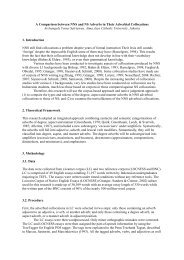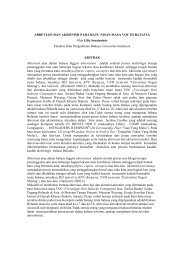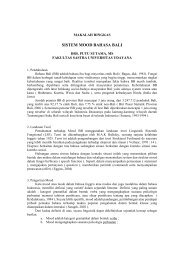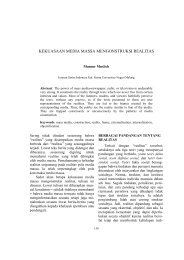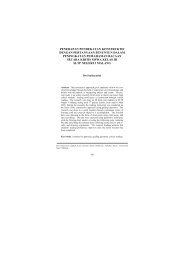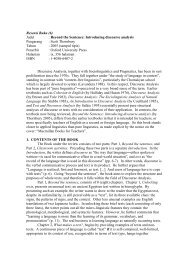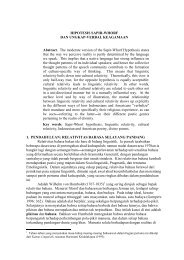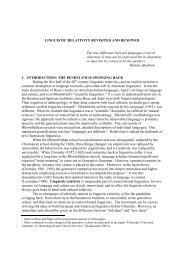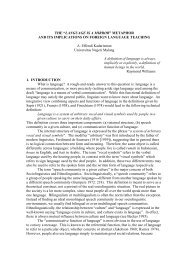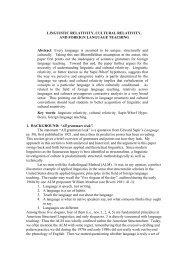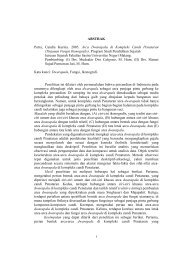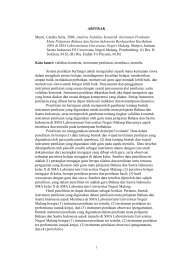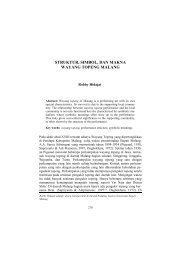a brief look at roman jakobson s six lectures on sound and meaning
a brief look at roman jakobson s six lectures on sound and meaning
a brief look at roman jakobson s six lectures on sound and meaning
Create successful ePaper yourself
Turn your PDF publications into a flip-book with our unique Google optimized e-Paper software.
A BRIEF LOOK AT ROMAN JAKOBSON S SIX LECTURES ON SOUND AND<br />
MEANING<br />
Ruruh Mindari<br />
FKIP UNIKA Widya M<strong>and</strong>ala<br />
Abstract: One of the founders of the Prague School of Linguistics was a Russianborn<br />
American, Roman Jakobs<strong>on</strong> (1896-1982). This article presents a summary of<br />
his famous Six Lectures <strong>on</strong> Sound <strong>and</strong> Meaning (1942). In the <str<strong>on</strong>g>lectures</str<strong>on</strong>g>, he argues<br />
th<str<strong>on</strong>g>at</str<strong>on</strong>g> acoustic ph<strong>on</strong>etics (<strong>sound</strong>s) is a quite significant aspect in communic<str<strong>on</strong>g>at</str<strong>on</strong>g>i<strong>on</strong><br />
because of its intim<str<strong>on</strong>g>at</str<strong>on</strong>g>e rel<str<strong>on</strong>g>at</str<strong>on</strong>g>i<strong>on</strong>ship with <strong>meaning</strong>. Yet, people have been paying<br />
more <str<strong>on</strong>g>at</str<strong>on</strong>g>tenti<strong>on</strong> to articul<str<strong>on</strong>g>at</str<strong>on</strong>g>ory ph<strong>on</strong>etics or how <strong>sound</strong>s are produced. The article<br />
also discusses the strengths, weaknesses, <strong>and</strong> c<strong>on</strong>tributi<strong>on</strong>s of the <str<strong>on</strong>g>lectures</str<strong>on</strong>g> to TEFL<br />
or SLA.<br />
Key words: <strong>sound</strong>, <strong>meaning</strong>, acoustic, motor, signifier, signified.<br />
One of Jakobs<strong>on</strong> s brilliant ideas is reflected<br />
in his famous Six Lectures <strong>on</strong> Sound <strong>and</strong><br />
Meaning (1942). Jakobs<strong>on</strong> starts his first<br />
lecture by referring to Edgar Allan Poe s<br />
poem The Raven (1845). The narr<str<strong>on</strong>g>at</str<strong>on</strong>g>ive<br />
poem, which c<strong>on</strong>sists of eighteen stanzas,<br />
is noted for its musicality, stylized<br />
language, <strong>and</strong> supern<str<strong>on</strong>g>at</str<strong>on</strong>g>ural <str<strong>on</strong>g>at</str<strong>on</strong>g>mosphere. It<br />
tells of a talking raven s mysterious visit to<br />
a distraught lover, tracing the l<str<strong>on</strong>g>at</str<strong>on</strong>g>ter s slow<br />
descent into madness. The lover is<br />
160<br />
lamenting the loss of his love, Lenore. The<br />
raven seems to further investig<str<strong>on</strong>g>at</str<strong>on</strong>g>e his<br />
distress with its c<strong>on</strong>stant repetiti<strong>on</strong> of the<br />
word Nevermore (Wikipedia Encyclopedia)<br />
th<str<strong>on</strong>g>at</str<strong>on</strong>g> appears <str<strong>on</strong>g>at</str<strong>on</strong>g> the ends of the last<br />
eleven stanzas. The quot<str<strong>on</strong>g>at</str<strong>on</strong>g>i<strong>on</strong> below is the<br />
first two <strong>and</strong> the last two stanzas of the<br />
poem.<br />
Once up<strong>on</strong> a midnight dreary, while I<br />
p<strong>on</strong>dered weak <strong>and</strong> weary,<br />
Over many a quaint <strong>and</strong> curious volume of forgotten lore,<br />
While I nodded, nearly napping, suddenly there came a tapping,<br />
As of some<strong>on</strong>e gently rapping, rapping <str<strong>on</strong>g>at</str<strong>on</strong>g> my chamber door.<br />
Tis some visitor, I muttered, tapping <str<strong>on</strong>g>at</str<strong>on</strong>g> my chamber door -<br />
Only this, <strong>and</strong> nothing more.<br />
Ah, distinctly I remember it was in the bleak December,<br />
And each separ<str<strong>on</strong>g>at</str<strong>on</strong>g>e dying ember wrought its ghost up<strong>on</strong> the floor.<br />
Eagerly I wished the morrow; - vainly I had sought to borrow<br />
From my books surcease of sorrow-sorrow for the lost Lenore -
3 BAHASA DAN SENI, Tahun 36, Nomor 2, Agustus 2008<br />
For the rare <strong>and</strong> radiant maiden whom the angels named Lenore -<br />
Nameless here for evermore.<br />
Be th<str<strong>on</strong>g>at</str<strong>on</strong>g> word our sign of parting, bird or fiend! I shrieked upstarting<br />
Get thee back into the tempest <strong>and</strong> the Night s Plut<strong>on</strong>ian shore!<br />
Leave no black plume as a token of th<str<strong>on</strong>g>at</str<strong>on</strong>g> lie thy soul h<str<strong>on</strong>g>at</str<strong>on</strong>g>h spoken!<br />
Lave my l<strong>on</strong>eliness unbroken! quit the bust above my door!<br />
Take thy beak from out my heart, <strong>and</strong> take thy form from off my door!<br />
Quoth the raven, Nevermore.<br />
And the raven, never flitting, still is sitting, still is sitting<br />
On the pallid bust of Pallas just above my chamber door;<br />
And his eyes have all the seeming of a dem<strong>on</strong> s th<str<strong>on</strong>g>at</str<strong>on</strong>g> is dreaming,<br />
And the lamp-light o er him streaming throws his shadow <strong>on</strong> the floor;<br />
And my soul from out th<str<strong>on</strong>g>at</str<strong>on</strong>g> shadow th<str<strong>on</strong>g>at</str<strong>on</strong>g> lies flo<str<strong>on</strong>g>at</str<strong>on</strong>g>ing <strong>on</strong> the floor<br />
Shall be lifted nevermore!<br />
(Behme, 2007)<br />
Jakobs<strong>on</strong> sees the repe<str<strong>on</strong>g>at</str<strong>on</strong>g>ed word croaking of a raven, <strong>and</strong> which was even<br />
Nevermore in the poem rich in semantic the inspir<str<strong>on</strong>g>at</str<strong>on</strong>g>i<strong>on</strong> for the whole poem. In<br />
c<strong>on</strong>tent though c<strong>on</strong>sisting of <strong>on</strong>ly a few additi<strong>on</strong>, it is nevertheless certain th<str<strong>on</strong>g>at</str<strong>on</strong>g><br />
<strong>sound</strong>s. It is able to project us into the vari<str<strong>on</strong>g>at</str<strong>on</strong>g>i<strong>on</strong> of its ph<strong>on</strong>ic qualities th<str<strong>on</strong>g>at</str<strong>on</strong>g> allow<br />
future, or even into eternity. Within the the emotive value of the word to be<br />
c<strong>on</strong>text of the dialogue, the word c<strong>on</strong>veys a quantit<str<strong>on</strong>g>at</str<strong>on</strong>g>ively varied in all kinds of ways.<br />
series of <strong>meaning</strong>s: you will never forget The word Nevermore involves <strong>on</strong>ly a<br />
her, you will never regain peace of mind, small number of articul<str<strong>on</strong>g>at</str<strong>on</strong>g>ory moti<strong>on</strong>s to be<br />
you will never again embrace her, I will heard, yet, in The Raven , it expresses <strong>and</strong><br />
never leave you! Besides, it can functi<strong>on</strong> as communic<str<strong>on</strong>g>at</str<strong>on</strong>g>es a wealth of c<strong>on</strong>ceptual,<br />
the symbolic name the poet gives to the emotive, <strong>and</strong> aesthetic c<strong>on</strong>tent. According<br />
raven, his nocturnal visitor.<br />
to Jakobs<strong>on</strong>, this is the mystery of the idea<br />
The value of the expressi<strong>on</strong>, however, is embodied in ph<strong>on</strong>ic m<str<strong>on</strong>g>at</str<strong>on</strong>g>ter.<br />
not entirely accounted for its semantic As it has been known, a word, like any<br />
value, but also its general <strong>meaning</strong> plus its verbal sign, is a unity of <strong>sound</strong> <strong>and</strong> <strong>meaning</strong><br />
c<strong>on</strong>textual <strong>on</strong>e. The poet himself says th<str<strong>on</strong>g>at</str<strong>on</strong>g> (Saussure s terms signifier <strong>and</strong> signified )<br />
it was the potential <strong>on</strong>om<str<strong>on</strong>g>at</str<strong>on</strong>g>opoeic quality th<str<strong>on</strong>g>at</str<strong>on</strong>g> diagramm<str<strong>on</strong>g>at</str<strong>on</strong>g>ically is represented as<br />
of the <strong>sound</strong>s of the word nevermore which<br />
suggested to him its associ<str<strong>on</strong>g>at</str<strong>on</strong>g>i<strong>on</strong> with the<br />
follows:<br />
Signified
161 BAHASA DAN SENI, Tahun 36, Nomor 2, Agustus 2008<br />
The combin<str<strong>on</strong>g>at</str<strong>on</strong>g>i<strong>on</strong> is perfectly clear, yet,<br />
the structure remains unobvious. Wh<str<strong>on</strong>g>at</str<strong>on</strong>g> is<br />
the rel<str<strong>on</strong>g>at</str<strong>on</strong>g>i<strong>on</strong> between <strong>sound</strong> <strong>and</strong> <strong>meaning</strong><br />
within a word, or within language<br />
generally? How can the <strong>sound</strong>s functi<strong>on</strong> as<br />
the vehicle for the <strong>meaning</strong>?<br />
Str<strong>on</strong>gly Jakobs<strong>on</strong> argued th<str<strong>on</strong>g>at</str<strong>on</strong>g> how<br />
<strong>sound</strong>s functi<strong>on</strong> was indeed worth<br />
investig<str<strong>on</strong>g>at</str<strong>on</strong>g>ing. In fact, it was how to produce<br />
<strong>sound</strong>s th<str<strong>on</strong>g>at</str<strong>on</strong>g> people were busy with. They<br />
paid <str<strong>on</strong>g>at</str<strong>on</strong>g>tenti<strong>on</strong> more <strong>on</strong> the motor aspects<br />
of speech r<str<strong>on</strong>g>at</str<strong>on</strong>g>her than the acoustic.<br />
He<br />
emphasized th<str<strong>on</strong>g>at</str<strong>on</strong>g> the immedi<str<strong>on</strong>g>at</str<strong>on</strong>g>e goal of the<br />
ph<strong>on</strong><str<strong>on</strong>g>at</str<strong>on</strong>g>ory act is the acoustic phenomen<strong>on</strong><br />
itself, not the motor. It is the acoustic th<str<strong>on</strong>g>at</str<strong>on</strong>g><br />
a speaker aims <str<strong>on</strong>g>at</str<strong>on</strong>g> producing, <strong>and</strong> it is the<br />
acoustic phenomen<strong>on</strong><br />
th<str<strong>on</strong>g>at</str<strong>on</strong>g><br />
is directly<br />
accessible to the listener.<br />
Yet, ph<strong>on</strong>etics in the neogrammarian<br />
period c<strong>on</strong>cerned itself in the first place<br />
with the articul<str<strong>on</strong>g>at</str<strong>on</strong>g>i<strong>on</strong> of <strong>sound</strong> <strong>and</strong> not with<br />
its acoustic aspect. The fact th<str<strong>on</strong>g>at</str<strong>on</strong>g> linguistic<br />
<strong>sound</strong>s are signifiers was deliber<str<strong>on</strong>g>at</str<strong>on</strong>g>ely put<br />
aside without regard for the role they play<br />
in language. Al<strong>on</strong>g with the advancement<br />
of technology, X-ray photography was used<br />
to reveal the functi<strong>on</strong>ing of the vocal<br />
appar<str<strong>on</strong>g>at</str<strong>on</strong>g>us in all its details. L<str<strong>on</strong>g>at</str<strong>on</strong>g>er,<br />
radiography brought to light the crucial role<br />
of the hidden parts of the vocal appar<str<strong>on</strong>g>at</str<strong>on</strong>g>us<br />
so th<str<strong>on</strong>g>at</str<strong>on</strong>g> the importance of the hyoid b<strong>on</strong>e,<br />
the epiglottis, the pharynx, <strong>and</strong> the soft<br />
pal<str<strong>on</strong>g>at</str<strong>on</strong>g>e became much better known.<br />
Nevertheless, as Ferdin<strong>and</strong> de Saus-sure<br />
had explained in his Cours de linguistique<br />
general<br />
l<strong>on</strong>g before those equipments<br />
were invented, even people could record<br />
<strong>on</strong> film all the movements of the mouth<br />
<strong>and</strong> larynx in producing a chain of <strong>sound</strong>s it<br />
is still impossible to discover subdivisi<strong>on</strong>s in<br />
the sequence of articul<str<strong>on</strong>g>at</str<strong>on</strong>g>ory movements. It<br />
is not known where <strong>on</strong>e <strong>sound</strong> begins <strong>and</strong><br />
where another ends. Further, the gre<str<strong>on</strong>g>at</str<strong>on</strong>g><br />
linguist st<str<strong>on</strong>g>at</str<strong>on</strong>g>es it is not the acoustic<br />
phenomen<strong>on</strong> in itself th<str<strong>on</strong>g>at</str<strong>on</strong>g> enables people<br />
to subdivide the speech chain into distinct<br />
elements; <strong>on</strong>ly the linguistic value of the<br />
pheno-men<strong>on</strong> can do th<str<strong>on</strong>g>at</str<strong>on</strong>g>.<br />
Saussure s predicti<strong>on</strong> was proved true<br />
by Menzer<str<strong>on</strong>g>at</str<strong>on</strong>g>h <strong>and</strong> his friend Arm<strong>and</strong>o<br />
Lacerda twenty years l<str<strong>on</strong>g>at</str<strong>on</strong>g>er who<br />
dem<strong>on</strong>str<str<strong>on</strong>g>at</str<strong>on</strong>g>ed th<str<strong>on</strong>g>at</str<strong>on</strong>g> the act of speech is a<br />
c<strong>on</strong>tinuous, uninterrupted movement<br />
(Koartikul<str<strong>on</strong>g>at</str<strong>on</strong>g>i<strong>on</strong>, Steuerung und Lautabgrenzung,<br />
1933). Whereas traditi<strong>on</strong>al<br />
doctrine had distinguished between<br />
positi<strong>on</strong>al <strong>sound</strong>s, which are held steady,<br />
<strong>and</strong> transiti<strong>on</strong>al <strong>sound</strong>s which lack this<br />
stability <strong>and</strong> which occur in the transiti<strong>on</strong><br />
from <strong>on</strong>e positi<strong>on</strong> to another, these two<br />
ph<strong>on</strong>eticians showed th<str<strong>on</strong>g>at</str<strong>on</strong>g> all <strong>sound</strong>s are in<br />
fact transiti<strong>on</strong>al. All above shows th<str<strong>on</strong>g>at</str<strong>on</strong>g><br />
however interesting <strong>and</strong> sophistic<str<strong>on</strong>g>at</str<strong>on</strong>g>ed is<br />
the study of motor ph<strong>on</strong>etics, it is no more<br />
than an auxiliary instrument for linguistics<br />
th<str<strong>on</strong>g>at</str<strong>on</strong>g> encourages the search for the<br />
principles of the organiz<str<strong>on</strong>g>at</str<strong>on</strong>g>i<strong>on</strong> of ph<strong>on</strong>ic<br />
m<str<strong>on</strong>g>at</str<strong>on</strong>g>ter.<br />
Although focusing <strong>on</strong> the motor aspect<br />
of the language, ph<strong>on</strong>eticians were unable<br />
to ignore the fact th<str<strong>on</strong>g>at</str<strong>on</strong>g> <strong>sound</strong> as such is an<br />
acoustic phenomen<strong>on</strong>. However, they<br />
believed th<str<strong>on</strong>g>at</str<strong>on</strong>g> there is <strong>on</strong>e-to-<strong>on</strong>e corresp<strong>on</strong>dence<br />
between the two aspects <strong>and</strong><br />
th<str<strong>on</strong>g>at</str<strong>on</strong>g> the classific<str<strong>on</strong>g>at</str<strong>on</strong>g>i<strong>on</strong> of motor phenomena<br />
has an exact equivalent in the<br />
classific<str<strong>on</strong>g>at</str<strong>on</strong>g>i<strong>on</strong> of acoustic phenomena.<br />
Therefore, by <strong>on</strong>ly c<strong>on</strong>structing the former,<br />
the l<str<strong>on</strong>g>at</str<strong>on</strong>g>ter will autom<str<strong>on</strong>g>at</str<strong>on</strong>g>ically follow from it.<br />
This argument, which has many<br />
implic<str<strong>on</strong>g>at</str<strong>on</strong>g>i<strong>on</strong>s for linguistics, is utterly<br />
refuted now, c<strong>on</strong>tradicted by the facts.<br />
Acoustic ph<strong>on</strong>etics, with its deve-loping<br />
richness, already enables people to solve<br />
many of the mysteries of <strong>sound</strong>, mysteries<br />
which motor ph<strong>on</strong>etics could not even
egin to solve. In spite of its gre<str<strong>on</strong>g>at</str<strong>on</strong>g>er<br />
organizing power, however, just like motor<br />
ph<strong>on</strong>etics, acoustic fails to provide an<br />
aut<strong>on</strong>omous basis for the system<str<strong>on</strong>g>at</str<strong>on</strong>g>iz<str<strong>on</strong>g>at</str<strong>on</strong>g>i<strong>on</strong><br />
<strong>and</strong> the classific<str<strong>on</strong>g>at</str<strong>on</strong>g>i<strong>on</strong> of the ph<strong>on</strong>ic<br />
phenomena of language. It can give<br />
detailed micrographic image of each <strong>sound</strong>,<br />
but cannot interpret the image. When two<br />
<strong>sound</strong>s show both similarities <strong>and</strong><br />
dissimilarities, acoustics, having no intrinsic<br />
criteria to distinguish wh<str<strong>on</strong>g>at</str<strong>on</strong>g> is significant<br />
from wh<str<strong>on</strong>g>at</str<strong>on</strong>g> is not, does not know which <strong>on</strong>e<br />
is crucial in any given case. It cannot even<br />
tell whether it is a case of two variants of<br />
<strong>on</strong>e <strong>sound</strong> or of two different <strong>sound</strong>s.<br />
As faced with a similar problem in<br />
rel<str<strong>on</strong>g>at</str<strong>on</strong>g>i<strong>on</strong> to motor ph<strong>on</strong>etics it is crucial to<br />
ask wh<str<strong>on</strong>g>at</str<strong>on</strong>g> the immedi<str<strong>on</strong>g>at</str<strong>on</strong>g>e aim of <strong>sound</strong>s,<br />
c<strong>on</strong>sidered as acoustic phenomena is. This<br />
goes bey<strong>on</strong>d the level of the signi-fier, <strong>and</strong><br />
enters the domain of signified, the domain<br />
of <strong>meaning</strong>. It is not enough just to speak in<br />
order to be heard, but more than th<str<strong>on</strong>g>at</str<strong>on</strong>g>, to<br />
be heard in order to be understood. The<br />
journey goes from <strong>sound</strong> to <strong>meaning</strong>. Thus,<br />
in spite of staying in the territory of<br />
ph<strong>on</strong>etics, which studies <strong>sound</strong>s solely in<br />
their motor <strong>and</strong> acoustic aspects, it enters<br />
the territory of ph<strong>on</strong>o-logy, which studies<br />
the <strong>sound</strong>s of language in their linguistic<br />
aspect.<br />
Ph<strong>on</strong>ology, which used to rely far too<br />
much <strong>on</strong> a mechanistic <strong>and</strong> creeping<br />
empiri-cism, now seeks more <strong>and</strong> more to<br />
over-come the vestiges. It now investig<str<strong>on</strong>g>at</str<strong>on</strong>g>es<br />
speech <strong>sound</strong> in rel<str<strong>on</strong>g>at</str<strong>on</strong>g>i<strong>on</strong> to the<br />
<strong>meaning</strong>s with which they are invested, i.e.,<br />
<strong>sound</strong>s viewed as signifiers, <strong>and</strong> above all<br />
to throw light <strong>on</strong> the structure of the<br />
rel<str<strong>on</strong>g>at</str<strong>on</strong>g>i<strong>on</strong> between <strong>sound</strong>s <strong>and</strong> <strong>meaning</strong>.<br />
To analyze a word from the point of<br />
view of its ph<strong>on</strong>ic aspect, ph<strong>on</strong>ologists<br />
decompose it into a sequence of distinctive<br />
units, or ph<strong>on</strong>emes. The ph<strong>on</strong>eme,<br />
Mindari, A Brief Look <str<strong>on</strong>g>at</str<strong>on</strong>g> Roman Jakobs<strong>on</strong> s 162<br />
although an element <str<strong>on</strong>g>at</str<strong>on</strong>g> the service of<br />
<strong>meaning</strong>, is itself devoid of <strong>meaning</strong>. It is<br />
the smallest linguistic entity composed of a<br />
bundle of distinctive fe<str<strong>on</strong>g>at</str<strong>on</strong>g>ures. The<br />
distinctive fe<str<strong>on</strong>g>at</str<strong>on</strong>g>ures are subdivided into a<br />
class of inherent fe<str<strong>on</strong>g>at</str<strong>on</strong>g>ures, which are bound<br />
to the axis of simultaneity, <strong>and</strong> a class of<br />
prosodic <strong>on</strong>es involving the other axis, th<str<strong>on</strong>g>at</str<strong>on</strong>g><br />
of successi<strong>on</strong>.<br />
There are two essential characters<br />
c<strong>on</strong>tributed by Ferdin<strong>and</strong> de Saussure th<str<strong>on</strong>g>at</str<strong>on</strong>g><br />
become the fundamental principles of<br />
linguistic signs<br />
the linear character of the<br />
signifier <strong>and</strong> the arbitrariness of the sign.<br />
He also s<str<strong>on</strong>g>at</str<strong>on</strong>g>ed th<str<strong>on</strong>g>at</str<strong>on</strong>g> there is no internal<br />
rel<str<strong>on</strong>g>at</str<strong>on</strong>g>i<strong>on</strong> between signified <strong>and</strong> its<br />
signifier , for instance, the signified ox has<br />
as its signifier b- -f (b uf) <strong>on</strong> <strong>on</strong>e side of<br />
the border <strong>and</strong> o-k-s (Ochs) <strong>on</strong> the other.<br />
The difference in value also happens in the<br />
French mout<strong>on</strong> <strong>and</strong> the English sheep<br />
(Course, 160/115).<br />
In other words, accor-<br />
ding to de Saussure, there is neither<br />
signified without signifier nor signifier<br />
without signified in language.<br />
his opini<strong>on</strong> is opposed by Emile Benveniste,<br />
a profound French linguist, in his<br />
article in Acta Linguistica (1939) th<str<strong>on</strong>g>at</str<strong>on</strong>g> says<br />
the c<strong>on</strong>necti<strong>on</strong> between the signifier <strong>and</strong><br />
the signified is not arbitrary; <strong>on</strong> the<br />
c<strong>on</strong>trary, it is necessary. For him the<br />
signified boeuf is inevitably tantamount to<br />
the signifier, the ph<strong>on</strong>ic group b-<br />
-f. They<br />
have been imprinted <strong>on</strong> his mind together;<br />
they are mutually evoc<str<strong>on</strong>g>at</str<strong>on</strong>g>ive in all<br />
circumstances.<br />
Different from Saussure s thesis, in<br />
Benveniste s<br />
opini<strong>on</strong>, the c<strong>on</strong>necti<strong>on</strong><br />
between signifier <strong>and</strong> signified is necessary;<br />
but <strong>on</strong>ly in the associ<str<strong>on</strong>g>at</str<strong>on</strong>g>i<strong>on</strong> based <strong>on</strong><br />
c<strong>on</strong>tiguity, <strong>and</strong> thus <strong>on</strong> an external rel<str<strong>on</strong>g>at</str<strong>on</strong>g>i<strong>on</strong>,<br />
whereas the internal <strong>on</strong>e is <strong>on</strong>ly occasi<strong>on</strong>al.<br />
It <strong>on</strong>ly appears in the peri-phery of the<br />
c<strong>on</strong>ceptual lexic<strong>on</strong>, in <strong>on</strong>om<str<strong>on</strong>g>at</str<strong>on</strong>g>opoeic <strong>and</strong>
163 BAHASA DAN SENI, Tahun 36, Nomor 2, Agustus 2008<br />
expressive words such as cuckoo, zigzag,<br />
crack, etc.<br />
The questi<strong>on</strong> of the internal rel<str<strong>on</strong>g>at</str<strong>on</strong>g>i<strong>on</strong><br />
between the <strong>sound</strong>s <strong>and</strong> the <strong>meaning</strong> of a<br />
word, however, is not exhausted. The intimacy<br />
of the c<strong>on</strong>necti<strong>on</strong> encourages<br />
speakers to add an internal rel<str<strong>on</strong>g>at</str<strong>on</strong>g>i<strong>on</strong> to the<br />
external <strong>on</strong>e, resemblance to c<strong>on</strong>tiguity, to<br />
complement the signified by a rudimentary<br />
image. They use ph<strong>on</strong>ic oppositi<strong>on</strong>s<br />
to evoke rel<str<strong>on</strong>g>at</str<strong>on</strong>g>i<strong>on</strong>s with musical,<br />
chrom<str<strong>on</strong>g>at</str<strong>on</strong>g>ic, olfactory, tactile, etc. sens<str<strong>on</strong>g>at</str<strong>on</strong>g>i<strong>on</strong>s.<br />
The oppositi<strong>on</strong> between acute <strong>and</strong><br />
grave ph<strong>on</strong>emes, for instance, suggests an<br />
image of bright <strong>and</strong> dark, pointed <strong>and</strong><br />
rounded, thin <strong>and</strong> thick, light <strong>and</strong> heavy,<br />
etc. The <strong>sound</strong> symbolism, using Edward<br />
Sapir s term, or the inner value of the<br />
distinctive fe<str<strong>on</strong>g>at</str<strong>on</strong>g>ures, although l<str<strong>on</strong>g>at</str<strong>on</strong>g>ent, is<br />
brought to life as so<strong>on</strong> as it finds a<br />
corresp<strong>on</strong>dence in the <strong>meaning</strong> of a given<br />
word <strong>and</strong> in our emoti<strong>on</strong>al or aesthetic<br />
<str<strong>on</strong>g>at</str<strong>on</strong>g>titude towards this word <strong>and</strong> even more<br />
towards pairs of words with two opposite<br />
<strong>meaning</strong>s.<br />
In poetic language, where the sign as<br />
such takes <strong>on</strong> an aut<strong>on</strong>omous value, the<br />
<strong>sound</strong> symbolism becomes an actual factor<br />
<strong>and</strong> cre<str<strong>on</strong>g>at</str<strong>on</strong>g>es a sort of accom-paniment to<br />
the signified. The investi-g<str<strong>on</strong>g>at</str<strong>on</strong>g>i<strong>on</strong> of the<br />
symbolic value of ph<strong>on</strong>emes invites the risk<br />
of giving rise to am-biguous <strong>and</strong> trivial<br />
interpret<str<strong>on</strong>g>at</str<strong>on</strong>g>i<strong>on</strong>s because ph<strong>on</strong>emes are<br />
complex entities, bundles of distinctive<br />
fe<str<strong>on</strong>g>at</str<strong>on</strong>g>ures. This fact will result in an<br />
appositive character th<str<strong>on</strong>g>at</str<strong>on</strong>g> leads to<br />
synaesthesia, as shown in the language of<br />
children.<br />
STRENGTHS AND WEAKNESSES<br />
The core of Jakobs<strong>on</strong> s <str<strong>on</strong>g>lectures</str<strong>on</strong>g> <strong>on</strong><br />
<strong>sound</strong> <strong>and</strong> <strong>meaning</strong> is quite striking. It<br />
makes us aware th<str<strong>on</strong>g>at</str<strong>on</strong>g> <strong>sound</strong> plays a very<br />
important role in cre<str<strong>on</strong>g>at</str<strong>on</strong>g>ing <strong>meaning</strong> especially<br />
to the listener. For the listener, it<br />
does not really m<str<strong>on</strong>g>at</str<strong>on</strong>g>ter how the speaker<br />
produces the <strong>sound</strong>. The most important<br />
thing is th<str<strong>on</strong>g>at</str<strong>on</strong>g> the former can hear <strong>and</strong><br />
underst<strong>and</strong> it. For example, when I hear<br />
some<strong>on</strong>e talk to me Thirty kilometers I<br />
do not care how s/he oper<str<strong>on</strong>g>at</str<strong>on</strong>g>es his/her<br />
t<strong>on</strong>gue <strong>and</strong> vocal cords, whether the tip of<br />
the t<strong>on</strong>gue is put between two rows of<br />
teeth or not, or whether the l<str<strong>on</strong>g>at</str<strong>on</strong>g>ter vibr<str<strong>on</strong>g>at</str<strong>on</strong>g>es<br />
or not. Wh<str<strong>on</strong>g>at</str<strong>on</strong>g> is important for me is I can<br />
hear the utterance <strong>and</strong> underst<strong>and</strong> it<br />
correctly. It is thirty kilometers, not dirty<br />
pillow meters.<br />
Another point worth noting is th<str<strong>on</strong>g>at</str<strong>on</strong>g><br />
<strong>sound</strong> symbolism, or the inner value of the<br />
distinc-tive fe<str<strong>on</strong>g>at</str<strong>on</strong>g>ures, although seemingly<br />
<strong>meaning</strong>-less, becomes <strong>meaning</strong>ful as so<strong>on</strong><br />
as it finds a corresp<strong>on</strong>dence in the <strong>meaning</strong><br />
of a given word <strong>and</strong> in our emoti<strong>on</strong>al or<br />
aesthetic <str<strong>on</strong>g>at</str<strong>on</strong>g>titude towards this word. In the<br />
Javanese traditi<strong>on</strong>al liter<str<strong>on</strong>g>at</str<strong>on</strong>g>ure, especially<br />
children playing s<strong>on</strong>gs, many n<strong>on</strong>sense<br />
words are used as the accompaniment to<br />
the signified. Let us see the following<br />
traditi<strong>on</strong>al s<strong>on</strong>g enti-tled Cing C<strong>on</strong>g Cing<br />
Cohung.<br />
Cing c<strong>on</strong>g cing cohung<br />
Cing c<strong>on</strong>g cing cohung<br />
Kowe bocah kuncung<br />
Uwis awan isih njingkrung<br />
Kae, bocah kuncung<br />
Kancamu wis padha rampung<br />
Enggal, bocah kuncung<br />
Cing c<strong>on</strong>g cing cohung.<br />
(APN in Prabowo et al., 2002)<br />
Cing c<strong>on</strong>g cing cohung<br />
Cing c<strong>on</strong>g cing cohung<br />
You, a forelock boy<br />
Still coiling <strong>on</strong> your bed <strong>on</strong> this high day<br />
Look, your friends are ready<br />
Hurry up, forelock boy!<br />
Cing c<strong>on</strong>g cing cohung.
Lexically the words cing c<strong>on</strong>g cing<br />
cohung do not mean anything; however, in<br />
the s<strong>on</strong>g above they become <strong>meaning</strong>-ful<br />
because they cre<str<strong>on</strong>g>at</str<strong>on</strong>g>e comp<str<strong>on</strong>g>at</str<strong>on</strong>g>ibility between<br />
<strong>sound</strong> <strong>and</strong> <strong>meaning</strong>. Another example is in<br />
the chant entitled Mengko Sore Ngg<strong>on</strong>ku<br />
below:<br />
Mengko sore ngg<strong>on</strong>ku ku<br />
Arep ana wayang<br />
Mengko sore aku ku<br />
Ndelok s<strong>and</strong>hing dhalang<br />
Engek engo-ek gung<br />
Engek engo-ek po<br />
Engek engo-ek gung<br />
Engek engo-ek g<strong>on</strong>g.<br />
(APN in Prabowo et al., 2002)<br />
There will be a puppet shadow performance<br />
<str<strong>on</strong>g>at</str<strong>on</strong>g> my village this evening<br />
I will w<str<strong>on</strong>g>at</str<strong>on</strong>g>ch near the puppet master this<br />
evening<br />
Engek engo-ek gung<br />
Engek engo-ek po<br />
Engek engo-ek gung<br />
Engek engo-ek g<strong>on</strong>g<br />
The n<strong>on</strong>sense words in the above lines --<br />
Engek engo-ek gung/ Engek engo-ek po/<br />
Engek engo-ek gung/ Engek engo-ek g<strong>on</strong>gseem<br />
unrel<str<strong>on</strong>g>at</str<strong>on</strong>g>ed to the other lines, neither<br />
for <strong>meaning</strong> nor for rhyming. Yet, they<br />
build a unity th<str<strong>on</strong>g>at</str<strong>on</strong>g> cannot be separa-ted<br />
from the others. A probable reas<strong>on</strong> for<br />
using the <strong>sound</strong> engek engo-ek is th<str<strong>on</strong>g>at</str<strong>on</strong>g> it<br />
represents the <strong>sound</strong> of rebab, a Javanese<br />
violin in the gamelan orchestra accompanying<br />
the performance, while gung<br />
<strong>and</strong> g<strong>on</strong>g<br />
represent th<str<strong>on</strong>g>at</str<strong>on</strong>g> of g<strong>on</strong>g, another<br />
musical instrument.<br />
Besides showing the remarkable<br />
strengths, Jakobs<strong>on</strong> himself has identified<br />
the weaknesses of acoustic ph<strong>on</strong>etics. It<br />
fails to provide an aut<strong>on</strong>omous basis for<br />
the system<str<strong>on</strong>g>at</str<strong>on</strong>g>iz<str<strong>on</strong>g>at</str<strong>on</strong>g>i<strong>on</strong> <strong>and</strong> the classific<str<strong>on</strong>g>at</str<strong>on</strong>g>i<strong>on</strong> of<br />
the ph<strong>on</strong>ic phenomena of language. It can<br />
give detailed micrographic image of each<br />
<strong>sound</strong>, but cannot interpret the image.<br />
Mindari, A Brief Look <str<strong>on</strong>g>at</str<strong>on</strong>g> Roman Jakobs<strong>on</strong> s 164<br />
When two <strong>sound</strong>s show both similarities<br />
<strong>and</strong> dissimilarities, acoustics does not know<br />
which <strong>on</strong>e is crucial in any given case. It<br />
cannot even tell whether it is a case of two<br />
variants of <strong>on</strong>e <strong>sound</strong> or of two different<br />
<strong>sound</strong>s.<br />
Wh<str<strong>on</strong>g>at</str<strong>on</strong>g> I found, if it may be called a<br />
weakness, is th<str<strong>on</strong>g>at</str<strong>on</strong>g> although it is crucial to<br />
study acoustic ph<strong>on</strong>etics, articul<str<strong>on</strong>g>at</str<strong>on</strong>g>ory<br />
ph<strong>on</strong>etics is also important especially for<br />
language learners who have difficulties in<br />
pr<strong>on</strong>unci<str<strong>on</strong>g>at</str<strong>on</strong>g>i<strong>on</strong>. In other words, it is help-ful<br />
for language learners in the effort to be<br />
able to speak appropri<str<strong>on</strong>g>at</str<strong>on</strong>g>ely in order th<str<strong>on</strong>g>at</str<strong>on</strong>g><br />
other people underst<strong>and</strong> them. For<br />
example, how to produce the <strong>sound</strong> /<br />
/ in<br />
the article the or they as c<strong>on</strong>trasted to the<br />
<strong>sound</strong> / / in the word three or thirsty .<br />
THE CONTRIBUTIONS TO TEFL OR SLA<br />
The c<strong>on</strong>tributi<strong>on</strong>s of this school to TEFL<br />
or SLA, as I can see, are in the ALM (Audio<br />
Lingual Method) <strong>and</strong> in teaching Liter<str<strong>on</strong>g>at</str<strong>on</strong>g>ure,<br />
especially Poetry. I do not menti<strong>on</strong> the<br />
development of Semantics here, as it is<br />
closer to Linguis-tics. As we know, oral drills<br />
are quite dominant in the ALM. Therefore,<br />
<strong>sound</strong>s play an important role in the<br />
teaching learning activities. In teaching<br />
English to young learners, the teacher also<br />
often uses s<strong>on</strong>gs or chants in which there<br />
are rhymes. Children like to hear <strong>and</strong><br />
repe<str<strong>on</strong>g>at</str<strong>on</strong>g> rhyming <strong>sound</strong>s <strong>and</strong>, accompanied<br />
with gestures, they learn the <strong>meaning</strong> of<br />
the words easily. Look <str<strong>on</strong>g>at</str<strong>on</strong>g> the s<strong>on</strong>g entitled<br />
Row, row your bo<str<strong>on</strong>g>at</str<strong>on</strong>g> below:<br />
Row, row, row your bo<str<strong>on</strong>g>at</str<strong>on</strong>g><br />
Gently down the stream<br />
Merrily, merrily, merrily<br />
Life is just a dream<br />
The repe<str<strong>on</strong>g>at</str<strong>on</strong>g>ed words row , <strong>and</strong> merrily ,<br />
plus the repe<str<strong>on</strong>g>at</str<strong>on</strong>g>ed <strong>sound</strong> /i:m/ make this<br />
s<strong>on</strong>g interesting for children to sing.
165 BAHASA DAN SENI, Tahun 36, Nomor 2, Agustus 2008<br />
Moreover, while acting it out like the<br />
teacher, they learn the <strong>meaning</strong> of the<br />
words row <strong>and</strong> merrily . Another example<br />
is a popular s<strong>on</strong>g Old Mc D<strong>on</strong>ald :<br />
Old Mc D<strong>on</strong>ald had a farm, ei-ei-o<br />
In all his farm he had some chicks, ei-ei-o<br />
With the chick-chick here<br />
With the chick-chick there<br />
Everywhere are chick, chick<br />
Old Mc D<strong>on</strong>ald had a farm, ei-ei-o<br />
The n<strong>on</strong>sense <strong>sound</strong>s ei-ei-o cre<str<strong>on</strong>g>at</str<strong>on</strong>g>e joy<br />
in this s<strong>on</strong>g, while chick-chick , besi-des<br />
telling the <strong>meaning</strong> of the word chick<br />
itself, emphasize the idea th<str<strong>on</strong>g>at</str<strong>on</strong>g> there are<br />
many chicks in the farm. When hearing this<br />
s<strong>on</strong>g, <strong>on</strong>e will imagine a farm with chicks<br />
everywhere.<br />
The intim<str<strong>on</strong>g>at</str<strong>on</strong>g>e rel<str<strong>on</strong>g>at</str<strong>on</strong>g>i<strong>on</strong>ship between<br />
<strong>sound</strong> <strong>and</strong> <strong>meaning</strong> frequently occurs in<br />
poetry. We can feel it in a poem like<br />
Stopping by Woods <strong>on</strong> a Snowy Evening<br />
by Robert Frost, for example. The following<br />
lines are the first stanza of the poem. Let us<br />
read aloud each line slowly.<br />
Whose woods these are I think I know<br />
His house is in the village though<br />
He will not see me stopping here<br />
To w<str<strong>on</strong>g>at</str<strong>on</strong>g>ch his woods filled up with snow.<br />
The hollow <strong>sound</strong>s produced by the<br />
words know , though , <strong>and</strong> snow suggest<br />
silence, mysterious quietness<br />
accompanying the poet s deep<br />
c<strong>on</strong>templ<str<strong>on</strong>g>at</str<strong>on</strong>g>i<strong>on</strong>. Such an example <strong>and</strong><br />
explan<str<strong>on</strong>g>at</str<strong>on</strong>g>i<strong>on</strong> is important in helping<br />
students to go deeper in underst<strong>and</strong>ing a<br />
poem.<br />
In c<strong>on</strong>clusi<strong>on</strong>, with its strengths <strong>and</strong><br />
weaknesses, Jakobs<strong>on</strong> s Six Lectures <strong>on</strong><br />
Sound <strong>and</strong> Meaning is not <strong>on</strong>ly <strong>meaning</strong>ful<br />
to linguistic itself, but to some extent, it is<br />
also useful in the process of learning a<br />
sec<strong>on</strong>d or foreign language.<br />
REFERENCES:<br />
Jakobs<strong>on</strong>, Roman. 1942. Six Lectures <strong>on</strong><br />
Sound <strong>and</strong> Meaning, (Online),(http://www.marxist.org/reference<br />
/subject/philosophy/works/ru/<str<strong>on</strong>g>jakobs<strong>on</strong></str<strong>on</strong>g>.<br />
htm, retrieved <strong>on</strong> December15, 2007).<br />
Prabowo, Dhanu Priyo, R<str<strong>on</strong>g>at</str<strong>on</strong>g>naw<str<strong>on</strong>g>at</str<strong>on</strong>g>i, V.Risti,<br />
Suyami, <strong>and</strong> Mumfang<str<strong>on</strong>g>at</str<strong>on</strong>g>i, Titi. 2002.<br />
Geguritan Tradisi<strong>on</strong>al dalam Sastra<br />
Jawa. Jakarta: Pus<str<strong>on</strong>g>at</str<strong>on</strong>g> Ba-hasa,<br />
Departemen Pendidikan Nasi<strong>on</strong>al.<br />
Roman Jakobs<strong>on</strong>: Definiti<strong>on</strong> <strong>and</strong> Much<br />
More from Answers.com., (Online),(http://www.answers.com/topic/ro<br />
man-<str<strong>on</strong>g>jakobs<strong>on</strong></str<strong>on</strong>g>, retrieved <strong>on</strong> December<br />
15, 2007).<br />
Edgar Allan Poe. 1991. The Raven <strong>and</strong><br />
Other Favorite Poems ( Thrift Edi-ti<strong>on</strong>s).<br />
New York: Dover Public<str<strong>on</strong>g>at</str<strong>on</strong>g>i<strong>on</strong>.<br />
Saussure, Ferdin<strong>and</strong> de. 1959. Course in<br />
General Linguistic (English transl<str<strong>on</strong>g>at</str<strong>on</strong>g>i<strong>on</strong> by<br />
Wade Baskin). New York: McGraw-Hill<br />
Book Company.



